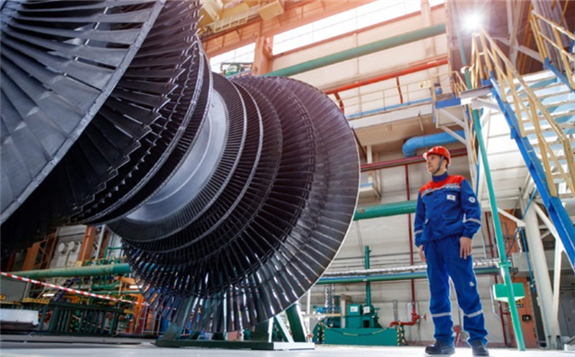Alexey Likhachov, director general of Rosatom, congratulated his staff today on the 75th anniversary of Russia's nuclear industry. To emphasise how the corporation is looking to the future, Rosatom has announced its switch to a 'united brand' by using its Mobius strip logo for all of its subsidiaries.

On 20 August 1945, the USSR created a special committee to supervise nuclear research, under the chairmanship of Lavrentii P. Beriia. This became a platform for the formation on 26 June 1953 of the Ministry of Medium Machine Building of the USSR.
"Today in Moscow we are unveiling a monument to Efim Pavlovich Slavsky, an outstanding figure in the 'atomic project', the Minister of Medium Machine Building, who was at the helm of the industry for almost 30 years," Likhachov said in a video address to Rosatom personnel.
The idea of using nuclear energy for power plants, ships and aircraft was put forward in 1947 and the first nuclear power plant, in Obninsk, was commissioned in 1954. Ten years later, the first VVER pressurised water reactor started operations at the Novovoronezh nuclear power plant.
"It was quite small by modern standards - only 210 MW, but its importance for the nuclear power industry was enormous," Likhachov said. "VVER technology produced six power unit designs, the latest of which is the Generation 3+ VVER-1200."
The world's first fast breeder reactor - the BN-350 - was commissioned in Kazakhstan in 1973 and the following year the first RBMK unit was commissioned, at the Leningrad nuclear power plant. By the mid-1980s, the total capacity of Soviet nuclear power plants reached a record capacity of 37 gigawatts, Likhachov said.
Since 2007, Rosatom has built 16 new nuclear power units in Russia and abroad. Recent achievements include the commissioning of VVER1200 reactors at the Leningrad II and Novovoronezh II plants, the BN-800 fast neutron reactor at Beloyarsk, and the Akademik Lomonosov floating nuclear power plant. Its new nuclear-powered icebreaker, Arktika, will be put into operation this year. Rosatom has diversified its uranium mining by expanding its presence in uranium projects in other countries, and now produces at least 8000 tonnes of uranium annually, Likhachov said.
"We have been developing cooperation with old partners - China, India, France, Hungary, Finland – and have acquired new ones - Turkey, Bangladesh, Belarus, Uzbekistan and Egypt," Likhachov said. "We have returned to the market for nuclear fuel supplies for plants in Eastern Europe, which was partially lost in the early 2000s. Now we are supplying 75 power units in Russia and 15 countries with fuel, which includes every sixth power reactor in the world. If during the Soviet era high-tech cooperation in the nuclear energy sector was developed with 19 countries, today we are working in more than 50 countries."
Summing up the results of the industry overs the last 75 years, Rosatom is "looking boldly to the future", he said, and working towards the goal of becoming, by 2030, "a global technological leader, not only in nuclear technologies, but also in the creation of new materials, renewables and hydrogen energy, and nuclear medicine". Other priorities are to achieve a closed fuel cycle and push ahead with research into plasma technologies and thermonuclear fusion, he added.
"Despite our 75th anniversary, our industry is still young and forward-looking. The key to our success lies in the experience of veterans and the enthusiasm of young people, coupled with the professionalism and dedication inherent in every nuclear engineer," he said.
Galymzhan Primatov, CEO of Kazatomprom, the world's biggest producer of uranium, sent his congratulations to Rosatom. He wrote: "I hope that Rosatom and Kazatomprom will continue constructive cooperation in the development of the peaceful use of nuclear energy for the benefit of our countries."
Looking ahead
Rosatom also announced today the launch of its rebranding campaign, which is part of its 'United Rosatom' strategy that was approved in April.
"While preserving their names and unique identity, the organisations of the Russian nuclear industry will get unified logos based on the trademark of the State Atomic Energy Corporation Rosatom - the Mobius strip," Rosatom said. "The use of an umbrella brand in the nuclear industry will enable the unified positioning of Rosatom organisations in domestic and foreign markets, which in turn will lead to higher recognition of Russian nuclear industry enterprises and their projects among partners and customers.
"It is rather symbolic that a large-scale industry rebranding campaign has coincided with the Russian nuclear industry’s 75th anniversary. Thus, on entering the next stage of its development, Rosatom will keep responding to contemporary challenges efficiently, working to create new opportunities for future generations," it said.
In its company newsletter, Rosatom said its annual revenue from overseas projects in 2019 was expected to reach a record of USD7.3 billion, up 10% compared to the previous year. As of late 2019, Rosatom was constructing 25 reactor units in nine countries with agreements reached for the construction of a total of 36 power units in 12 countries.
It is expected that Rosatom’s portfolio of international contracts for the next 10 years will exceed USD140 billion, up 5% compared to previous estimates. The total value of contracts related to the plants’ full service life is expected to reach USD202 billion. Revenue from overseas projects in 2020 is expected to exceed USD8 billion with more than a half coming from nuclear construction projects.